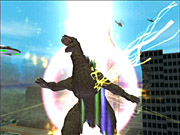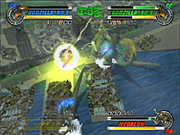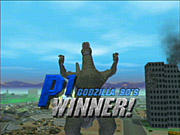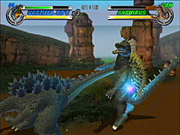Dating back to the 1950s, Godzilla is the undisputed king of movie monsters and a world-renowned icon that may be campy but certainly deserves every ounce of his fame. Japan's Toho Studios has created literally dozens of films to date starring this enormous radioactive lizard. Seeing any of them in this day and age, sometimes it's painfully apparent that proud Godzilla is really just a man in a rubber suit. But even after all these decades, you still can tell that tremendous effort and artistry must have gone into the making of these classic sci-fi films. The most well known of all of Godzilla's appearances has to be 1968's Destroy All Monsters, sort of a battle royal for Godzilla and his many terrific adversaries. It's this movie that was inspiration for a 3D fighting game for the GameCube, where players can assume the roles of nearly a dozen giant monsters and try to defeat all their opponents, with little regard for the cities in which the battles take place. It's a great concept, and Godzilla nuts will find it irresistibly appealing. Unfortunately, Godzilla: Destroy All Monsters Melee turns out to be quite shallow, and while it could easily tide over Godzilla fans for a while, it ultimately relies on the strength of its license to compensate for its weakness as a game.

Destroy All Monsters Melee is simple and shares elements in common with other multiplayer-focused beat-'em-up games like the GameCube's own Super Smash Bros. Melee or Capcom's Power Stone series. Generally speaking, though, it lacks these other games' smooth frame rates, its controls are pretty clunky, its collision detection doesn't look quite right, and the pacing of the action is a bit slow. Then again, none of those other games had Godzilla in them.
A number of different modes of play are available in Destroy All Monsters Melee, and while you might be inclined to cut straight to the four-player melee mode with a group of pals, you'll probably need to spend some time in the single-player adventure mode first. That's because initially just a measly three monsters are selectable: Godzilla (the '90s-era version), the spiny Anguirus, and the buglike Megalon. The rest must be unlocked by slogging through the adventure mode repeatedly, where you'll always take on a tough Mecha Godzilla as the final boss. Beating him, much less getting to him, may prove to be a challenge even on the easy setting for those who aren't very experienced with fighting games, since the computer fights dirty, often making a beeline for offscreen power-ups. Plus, you have only three chances to get through the adventure mode, and if you don't make it, you'll have to start over. There's also a versus mode for two players, a survival mode that puts more time pressure on you to defeat AI-controlled monsters, a team battle where you're only trying to defeat opposing team members, and a destruction mode where you merely try to wreak more havoc within a city than your opponent.

While the game has a good number of modes, your goal in most of these is to pound your enemy (or enemies) into submission using your monster's various attacks. Battles generally take place in urban environments that look boundless but in fact have artificial borders that confine the action to a relatively small area. These shimmering green "fences" also serve as a danger to be avoided, or exploited--monsters sustain some damage when they touch the edges of an arena, and you'll often be able to knock a foe into them, then smack the foe some more as it bounces back. You're otherwise free to run (or in some cases fly) about the area as you see fit, knocking down buildings as you go.
Beyond giving you some freedom of movement, Destroy All Monsters Melee functions like a conventional, rudimentary 3D fighting game. There isn't a ton of variation between the different controllable monsters when you get past their distinct appearances, and in fact, a few of them are essentially identical. As any of the monsters, you can execute several different attacks at the touch of a button, and you can also block, fire a beam weapon, and pick up and toss your opponent. Throws, overhead hits, and sweeps can all be used to crack an opposing monster's defenses, and each monster also has a number of special moves that are extremely easy to execute just by moving the analog stick in a direction while pressing a button. Many attacks in Destroy All Monsters Melee cause the monster on the receiving end to go flying, and should you find yourself knocked down, you can execute a couple of recovery moves to keep the opponent from pursuing his attack. All the constant knockdowns serve to add some drama to the proceedings, but since the game is filled with lumbering creatures that aren't exactly quick on their feet, you may find yourself annoyed at spending more time flopping around on the pavement than standing toe-to-toe with another monster.
True to the spirit of the Godzilla movies, the creatures in Destroy All Monsters Melee don't go down easily. No single move causes a lot of damage, so a sustained attack is the only way to win. The power-ups that occasionally appear can seriously help your cause, too. One gives you back a good chunk of your life bar, while another causes your monster to enter rage mode, during which you can execute a powerful special move that's practically unavoidable. Some monsters also deal double damage while in rage mode, which gives them an unbalancing advantage. Two other less useful power-ups are available: One instantly refills your beam weapon energy (which recharges quickly anyway), and another summons that no-good, two-timing, double-crossing Mothra to blast whoever didn't grab the item. At any rate, some power-ups can make a big difference, and the flying creatures of Destroy All Monsters Melee--including the birdlike Rodan and the three-headed King Ghidorah, as well as his cybernetic equivalent, Mecha King Ghidorah--have the advantage of being able to get to them more easily than most. Any creature, flying or not, can also use some of the small buildings (or other such blunt objects) as projectile weapons. It can be pretty satisfying to uproot a house and use it to finish off tough guys like Gigan and Destroyah.

Visually, Destroy All Monsters Melee can also be pretty satisfying at times, though the game's graphics aren't exactly polished and usually aren't very impressive. The frame rate of the game is never quite smooth, and it can fluctuate noticeably at times, like when you knock down a bunch of buildings and the screen fills with clouds of dust. Plus, the whole game just runs slower in some levels, apparently because they're more densely detailed than others. The monsters themselves are convincing representations of their cinematic counterparts and often look their best as they fire their blazing energy beams at one another. Certainly the most impressive monster of the lot is Mecha King Ghidorah, whose gold scales and reflective metal wings make him live up to his impressive name.
However, none of the monsters gives a convincing sense of the scale of the action--admittedly, though, this is a criticism that can be leveled at most Godzilla movies, too. For better or worse, then, because of the fast animations and quick recovery times on many of the moves in the game, the monsters in Destroy All Monsters Melee seem more like human-sized fighters duking it out in a miniature city than like the multistory behemoths they're supposed to be. The game's miniature cities do look good, though, and are based on real-world locations like Tokyo, London, Seattle, and San Francisco. You can destroy pretty much anything in any of the environments, which is a real plus.

The audio in Destroy All Monsters Melee is probably just the sort of cacophony you'd expect from the game. Most importantly, the monsters make their signature noises, and loud. The rest of the effects, such as when attacks connect and when monsters tumble to the ground, are serviceable though lacking in variety. An announcer introduces the monsters before a bout and proclaims the winner, but this guy sounds like he's talking about monster trucks rather than Godzilla and company. The game's music plays very, very softly (by default) amid the action, and though it's based on some of the outstanding symphonic music heard in the Godzilla films, it's overwhelmed by the rest of the audio. Those armed with Dolby Pro Logic II surround sound systems will be pleased to know that Destroy All Monsters Melee supports their setups. Crank up the volume, and your neighbors will think Godzilla's actually in the neighborhood.
It's hard to be too critical of Godzilla: Destroy All Monsters Melee, since even though there isn't a whole lot to it, you probably wouldn't expect this sort of game to offer a ton of depth. But since there's not much lasting value to look forward to from it once you get the character roster unlocked, Destroy All Monsters Melee is best suited as a rental. Anyway, it'll definitely get the job done if you and people you know are fans of the classic films, and it makes a decent party game in any context, though the pacing isn't quite as quick as your guests might like. There've been a number of Godzilla games in the past, and pretty much all of them were bad or at best mediocre. So if it makes you feel any better, Godzilla: Destroy All Monsters Melee is actually the best Godzilla game to date.